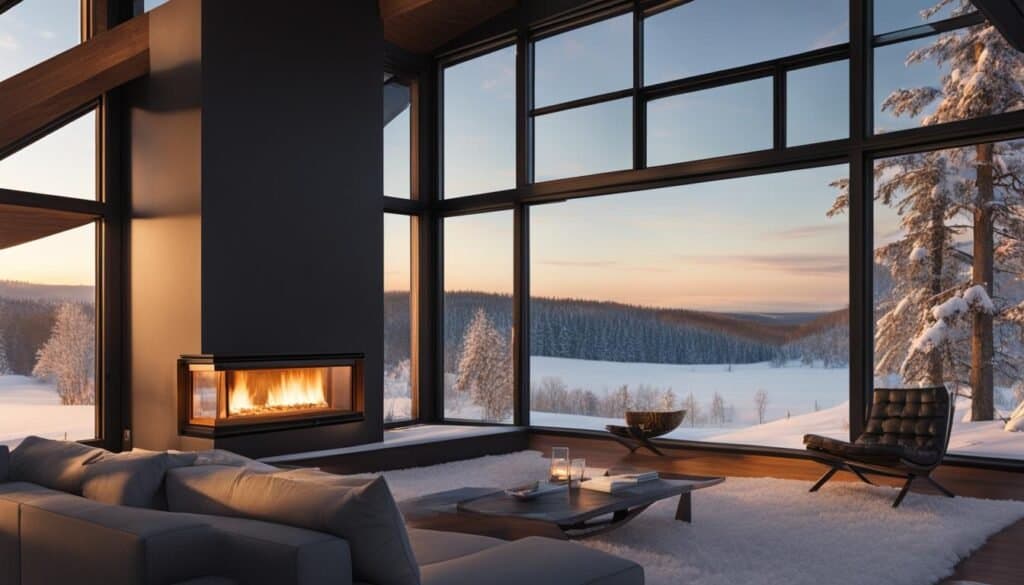As winter approaches and temperatures drop, maintaining a warm and comfortable home environment becomes a top priority. Thankfully, a variety of energy-saving heating systems for winter are available to effectively combat the cold while keeping energy costs and consumption in check. Armed with the right heating system for your home, you can keep your energy bills in control and save money this winter.
With so many energy-efficient home heating choices available, such as renewable energy sources for efficiency, you may feel overwhelmed when trying to find what fits your needs and budget best. So, let’s dive into the world of efficient heating and energy efficiency, exploring the best options for different climates and preferences.
Key Takeaways
- Energy-saving heating systems provide efficient warmth during winter while reducing energy consumption and costs.
- Renewable energy sources for efficiency, such as solar and geothermal heating, offer eco-friendly solutions to traditional heating methods.
- Smart thermostats give homeowners greater control over heating and cooling costs, while technology advancements offer increased energy efficiency and comfort.
- Upgrading your home’s insulation, alongside implementing an energy-saving heating system, maximizes comfort and energy efficiency.
- Considering your specific climate, budget, and home design helps identify the most suitable and cost-effective heating system for your needs.
Top 11 Energy-Saving Heating Systems
11 energy-saving heating systems suitable for winter climates, along with crucial information and illustrative examples for each:
- Geothermal Heat Pumps
- Overview: Utilizes the consistent temperature of the earth to heat and cool homes.
- Efficiency: Can reduce energy consumption by 25-50% compared to conventional systems.
- Illustration: In a 2,000 sq. ft. home, a geothermal system can save up to $1,500 annually in energy costs.
- Solar Heating
- Overview: Converts sunlight into thermal energy to heat indoor spaces.
- Efficiency: Solar panels can convert up to 80% of the sun’s radiation into heat.
- Illustration: A typical solar heating system can reduce a household’s carbon footprint by 3,000 pounds annually.
- Radiant Floor Heating
- Overview: Uses a system of pipes under the floor to distribute heat evenly.
- Efficiency: Can be up to 30% more efficient than forced-air heating.
- Illustration: Ideal for allergy sufferers as it doesn’t distribute allergens like forced air systems.
- High-Efficiency Wood Stoves
- Overview: Burns wood more efficiently than traditional fireplaces.
- Efficiency: Modern stoves can achieve an efficiency rating of 70% or higher.
- Illustration: A single load of wood can heat a space for several hours, reducing reliance on fossil fuels.
- Infrared Heaters
- Overview: Uses infrared light to heat objects and people directly, not the air.
- Efficiency: Instant heat with minimal energy loss.
- Illustration: Particularly effective in drafty areas or open spaces.
- Pellet Stoves
- Overview: Burns compressed wood or biomass pellets for heat.
- Efficiency: Can be over 80% efficient.
- Illustration: Pellet stoves require less storage space for fuel compared to traditional wood stoves.
- Heat Recovery Ventilators (HRV)
- Overview: Recovers heat from exhaust air and uses it to warm incoming fresh air.
- Efficiency: Can recover about 70-80% of the heat in the exhaust.
- Illustration: Ideal for tightly sealed homes, reducing the energy needed for heating fresh air.
- Ductless Mini-Split Systems
- Overview: Provides zoned heating without the need for extensive ductwork.
- Efficiency: Can reduce heating costs by up to 30% compared to central forced-air systems.
- Illustration: Perfect for heating individual rooms or additions where extending ductwork is impractical.
- Programmable Thermostats
- Overview: Allows precise control of heating systems, reducing energy waste.
- Efficiency: Can save about 10% a year on heating and cooling by adjusting temperatures while asleep or away.
- Illustration: Set the thermostat to lower temperatures when the house is empty, saving energy effortlessly.
- Condensing Boilers
- Overview: Utilizes the heat from exhaust gases that would otherwise be wasted.
- Efficiency: Can achieve efficiency levels of 90% or more.
- Illustration: Ideal for replacing older, less efficient boilers, leading to significant savings.
- Hybrid Systems
- Overview: Combines a gas furnace with an electric heat pump.
- Efficiency: The system automatically switches to the most efficient mode based on temperature.
- Illustration: During mild weather, the heat pump operates efficiently; in colder weather, the gas furnace takes over.
Each of these systems offers a unique approach to reducing energy consumption during the winter, catering to different needs and preferences while promoting environmental sustainability.
Embracing Eco-Friendly Heating: A Path to a Sustainable Home
In today’s environmentally conscious world, eco-friendly heating systems play a fundamental role in creating a sustainable and health-promoting home. As homeowners look to reduce their carbon footprint and embrace renewable energy sources, modern heat pumps and solar heating systems emerge as prominent figures in the energy-efficient landscape.
The Importance of Sustainability in Heating
With the ever-growing concern for our environment, transitioning to eco-friendly heating options allows us to reduce energy consumption while simultaneously improving the health of our planet. Heat pumps, such as the geothermal heat pump, work by extracting heat from the environment (air or ground) and are known for their energy-saving capabilities. Solar heating systems offer a renewable energy source that harnesses the inexhaustible energy from the sun, directly impacting energy savings and reducing greenhouse gas emissions.
How Eco-Friendly Heating Systems Contribute to a Healthier Environment
According to the Department of Energy, eco-friendly heating technologies can significantly cut heating expenses, with a two-fold benefit of reduced energy usage and lower energy bills. As a result, homeowners are presented with a win-win scenario: not only do they save on energy costs, but they also actively contribute to a healthier environment by reducing their carbon footprint. In essence, embracing eco-friendly and efficient heating choices is a practical step towards ensuring a comfortable, economically sound, and environmentally responsible household.
| Heating System | Energy Savings | Environmental Impact |
|---|---|---|
| Geothermal Heat Pump | 30% – 60%* | Significantly lower greenhouse gas emissions |
| Air Source Heat Pump | Up to 50%* | Lower greenhouse gas emissions compared to electric furnaces and baseboard heaters |
| Solar Heating | 50% – 80%* | Zero greenhouse gas emissions and renewable energy source |
*Percentage of energy savings compared to traditional heating systems.
In conclusion, eco-friendly heating systems offer a path towards a greener and more sustainable home. The adoption of heat pumps, geothermal heat pumps, and solar heating technologies can vastly improve energy savings and contribute to a healthier environment. Homeowners seeking to make a responsible heating choice can find comfort in the knowledge that they are positively impacting our planet for future generations.
Renewable Energy Sources for Efficiency
Renewable energy sources are rapidly becoming the cornerstone of not just an efficient heating system but also a sustainable energy policy for homes. Technologies like geothermal systems are at the forefront of this evolution, leveraging the consistent temperature beneath the Earth’s surface to provide heating and cooling. These systems are seen as consistent and reliable, typically resulting in lower heating costs and less environmental impact.
NRDC recommends keeping the heat inside by sealing air leaks around windows, doors, and other openings in your home, as well as using caulk and weatherstripping to prevent warm air from escaping.
Air-source heat technologies are gaining traction as well; they extract heat energy from the outside air to warm homes and can also reverse their function for cooling needs. These types of renewable energy not only bolster the efficiency of heating systems but reinforce the home as a bastion of energy efficiency. When coupled with ENERGY STAR-certified heating equipment, homeowners tap into some of the most advanced and energy-saving technologies available, acting both as an energy saver and a bulwark against rising energy costs.
“Geothermal and air-source heat technologies are transforming home heating, combining energy efficiency with environmentally friendly solutions.”
With the perfect balance of heating and cooling capabilities, renewable energy sources create an ideal environment for comfortable living while managing costs effectively. By embracing these advanced technologies, homeowners can pave the way for a more sustainable and energy-efficient future for their homes, benefiting both their wallets and the environment.
Smart Thermostats: A New Era of Home Temperature Control
In the age of rapidly advancing technology, smart thermostats have emerged as game-changers in the realm of home temperature control. These devices empower homeowners with newfound control over their heating and cooling costs and help to considerably lower energy consumption.
Understanding the Role of Programmable Thermostats
Programmable thermostats form the foundation of smart home temperature control. They facilitate the creation of customized heating schedules that align with daily routines, ensuring that energy is not wasted when heating or cooling is not essential. The outcome is a tangible reduction in energy consumption and lower heating bills. Furthermore, these modern thermostats can be controlled remotely through smartphones, making temperature adjustments a breeze, even when you’re on the go.
Customizing Your Heating Experience with Smart Technology
Smart thermostats elevate the home temperature control experience by learning and adapting to patterns and preferences. Incorporating user habits over time, these devices intelligently optimize heating efficiency and overall energy consumption. The U.S. Department of Energy has endorsed the use of smart thermostats, stating that careful utilization can result in up to a 10% reduction in heating and cooling costs.
From tailored heating experiences to improved energy efficiency, smart thermostats have set the stage for a new era in home temperature control. As more homeowners embrace these intelligent devices, the benefits of reduced energy consumption, lower heating bills, and a sustainable approach to home heating become increasingly indispensable.
Geothermal Heat Pumps: Harnessing the Earth’s Natural Warmth

As homeowners strive for a more efficient heating system and aim to reduce energy costs, geothermal heat pumps emerge as a highly attractive option. These innovative systems rely on the Earth’s natural temperature stability to provide both heating and cooling solutions throughout the year. By tapping into the planet’s natural resources, geothermal heat pumps offer a substantial advantage when it comes to long-term energy savings.
Compared to conventional heating systems, geothermal solutions are celebrated for their lower operational costs and reduced environmental impact. They achieve this by utilizing geothermal heat as a constant source of heat energy, subsequently cutting down on the amount of energy needed to heat a home. This innovative approach to home heating has resulted in the growing popularity of ground source heat pumps as a sustainable and efficient alternative.
Geothermal heat pumps capitalize on the Earth’s natural warmth to provide reliable home comfort while minimizing energy consumption.
In addition to their environmental benefits, geothermal heat pumps operate quietly and typically require less maintenance than other heating systems. This, combined with their ability to deliver consistent temperature control, makes them a top choice for homeowners taking a proactive approach towards energy efficiency.
- Lower operational costs compared to traditional heating systems
- Reduced environmental impact
- Quiet operation
- Long-term energy savings
- Less required maintenance
In conclusion, geothermal heat pumps stand as a testament to innovation and the power of the Earth’s natural resources. Finding a balance between energy savings, efficiency, and sustainability, these systems have a well-deserved place among the most sought-after heating solutions. By making the switch to a geothermal heat pump, homeowners can look forward to comfortable living, minimization of energy costs, and a more environmentally friendly home.
The Rise of Solar Heating: Clean and Cost-Effective Solutions

Solar heating exemplifies a clean, cost-effective heating solution that resonates with modern eco-conscious trends. As technology advances, integrating solar panels to bolster home heating efficiency has become increasingly popular. The clean nature of solar heating means no greenhouse gas emissions, positioning it as a forward-thinking choice for homeowners seeking both economic and ecological gains.
Solar Heating Basics and Benefits
The core concept of solar heating revolves around converting sunlight into thermal energy to heat homes, often without incurring the operating costs linked to conventional energy sources. The benefits are numerous and diverse, stemming from direct reductions in heating bills to the broader environmental advantages of adopting a renewable energy source. Furthermore, solar thermal systems can provide significant heating for water, further amplifying energy savings.
Integrating Solar Panels for Home Heating Efficiency
As homeowners seek ways to enhance heating efficiency and reduce energy consumption, solar panels have emerged as a popular option. Multiple solar panel configurations cater to various needs, from simple roof-mounted designs to elaborate ground-mounted arrays. The critical aspect lies in determining the best solar solution for each home layout to optimize energy production.
Example of energy savings by switching to solar heating:
| Home Heating Method | Average Annual Energy Cost | Estimated Savings with Solar Heating |
|---|---|---|
| Electric Resistance Heating | $500 | $350 |
| Natural Gas Heating | $750 | $525 |
| Oil Heating | $1,100 | $770 |
By integrating solar panels and harnessing the power of clean energy, homeowners can enjoy a multitude of benefits, including cost-effective heating solutions, heating efficiency, and a reduced environmental impact.
Hybrid Heating Systems: The Best of Both Worlds

Hybrid heating systems offer homeowners a perfect fusion of energy-efficient technology with the dependability of gas furnaces. By combining the best features of heat pumps and furnaces, these systems provide a versatile, cost-effective heating solution that caters to various climates and comfort preferences. In this section, we will discuss the dual fuel approach to home heating, optimal cases for choosing a hybrid system, and the benefits of ENERGY STAR-certified heat pumps.
Decoding the Hybrid Approach to Home Heating
Under the hybrid approach to home heating, hybrid heat pumps take center stage during milder temperatures. When the weather turns colder, they switch to dual fuel heating systems – a combination of heat pumps and gas furnaces – to maintain a comfortable indoor environment. This pairing optimizes energy usage while striking the perfect balance between comfort and energy savings.
Choosing a home heating system with an ENERGY STAR heat pump ensures that the homeowner receives the highest possible level of energy efficiency from their hybrid heating system. As a result, they’re able to enjoy cost-effective heating without sacrificing the performance of their setup.
When to Choose a Hybrid System for Optimal Energy Use
A hybrid heating system is the ideal heating option for homeowners living in areas where temperatures frequently dip below the optimal range for heat pump operation on their own. By combining heat pumps with gas furnaces, hybrid systems can help protect against increased energy consumption associated with extreme cold.
Investing in a heating and cooling system that utilizes this balanced approach ensures that homeowners have access to an efficient, responsive, and flexible home heating system that caters to their unique climate requirements. With a hybrid system in place, homeowners can enjoy peace of mind knowing they’re getting the best of both worlds: energy-efficient heating during milder temperatures and reliable backup heating during frigid weather.
Advanced Insulation Techniques to Complement Energy-Saving Heating

Proper insulation is the unsung hero of energy efficiency, working quietly behind the scenes to bolster the performance of heating systems while reducing energy costs significantly. Advanced insulation techniques have evolved, comprising a range of materials and methodologies that cater to various areas of a home. These include but are not limited to attic insulation, foundational insulation, and weatherization methods such as caulking and weather stripping.
These techniques prevent heat loss, manage cold air infiltration, and sustain a consistent indoor temperature. When executed correctly, innovative insulation strategies can radically improve energy consumption, lessen the workload on home heating systems, and thus minimize heating costs. Homeowners are now recognizing the value of an insulation upgrade as a complement to their energy-saving heating systems, reflecting a holistic approach to energy efficiency and home comfort management.
- Upgrade attic insulation to improve energy efficiency.
- Invest in foundational insulation to reduce heating and cooling costs.
- Employ weatherization methods, such as caulking and weather stripping, to enhance overall home comfort.
To provide a visual understanding of how various insulation types contribute to energy efficiency, the following table showcases the average R-value measurements for common insulation materials:
| Insulation Type | Average R-Value per Inch |
|---|---|
| Loose-fill cellulose | 3.2 – 3.8 |
| Fiberglass batts | 2.9 – 3.8 |
| Foam board | 3.6 – 6.5 |
| Loose-fill fiberglass | 2.2 – 2.7 |
| Sprayed foam | 3.5 – 6.5 |
By employing advanced insulation techniques, homeowners can significantly reduce their heating costs and improve energy consumption, creating a more comfortable and energy-efficient living space.
Conclusion on Energy-Saving Heating Systems for Winter
After delving into the world of energy-efficient heating systems and technologies, it’s evident that homeowners have a diverse range of options to choose from. These systems not only keep your home warm, but they also contribute to lowering your energy bill and making a positive impact on the environment. Among these choices, you may find furnaces, solar and geothermal systems, each with their own unique benefits and roles in energy-saving strategies.
Reviewing the Top Energy-Saving Heating Options
With so many efficient heating systems available, it’s essential to compare the top options like solar and geothermal systems, which boast eco-friendly advantages, or innovative central heating systems utilizing smart thermostats and hybrid technologies. These highly-efficient heating solutions are designed to cater to different budgets, climates, and home designs, allowing you to choose the best option to warm your home while keeping energy savings a priority.
Planning Your Transition to a More Energy-Efficient Heating System
When it’s time to transition to a more energy-efficient heating system, be prepared to weigh the immediate and long-term financial benefits, environmental impact, and the demands of your specific climate, home design, and budget. Upgrading your home heating system is a meaningful investment in your home’s future, with rewards encompassing not just comfort and savings but also sustainability. With careful consideration and planning, you can find the most effective solution that will provide lasting benefits for years to come.
FAQ on Efficient Heating Systems
Q: What types of heating systems are best for a cold climate?
A: For a cold climate, air-source heat pumps, especially those designed for cold weather, can be an efficient way to heat your home. They use electricity to move heat from the air outside your home to the inside. Other effective types of heating systems include radiant heating and heating oil.
Q: What is an air-source heat pump and how does it work in cold climates?
A: An air-source heat pump transfers heat from the outdoor air to inside your home. Even in extremely cold climates, there is still heat in the air that can be extracted by these highly efficient systems. They use much less energy than traditional heating systems, resulting in energy savings.
Q: What type of heat is most efficient for homeowners in colder climates?
A: Air-source heat is considered one of the most efficient when it comes to home heating options for cold climates. It uses less energy by leveraging heat from the air outside your home, even when it’s very cold. These systems can save significant amounts of energy.
Q: How can I find the most efficient heating system for my home in a cold climate?
A: To find the most efficient heating system, consider your local climate, your home’s insulation, and available energy sources. The best strategy is to compare different types of heating systems in terms of their seasonal energy efficiency rating, and possibly consult with a professional.
Q: What are some energy-saving tips for heating my home in a cold climate?
A: Firstly, ensure your home is properly insulated to retain heat. If using heaters, make sure they’re efficient and correctly sized for the space. Consider energy-efficient systems like air-source heat pumps. Lastly, regular maintenance of your heating system will ensure it’s running at peak efficiency.
Q: What are the least efficient heating options for cold climates?
A: Electric resistance heating is often the least efficient, as it requires a significant amount of energy to convert electricity into heat. Similarly, old and poorly maintained heating systems, irrespective of the heat source, can be less efficient.
Q: What are some new home heating system options for the winter climate?
A: Some of the new and efficient heating options include air-source heat pumps designed specifically for cold weather, high-efficiency furnaces, geothermal heat pumps that leverage the constant temperature of the earth, and radiant floor heating systems for even heat distribution.
Q: What distribution systems are best suited for cold climates?
A: Forced-air distribution systems are commonly used, but radiant heating systems can provide a higher level of comfort in cold climates. They distribute heat evenly and don’t cause drafts that you might experience with forced-air systems.
Q: What’s the most efficient heating source for heating my home in winter?
A: The most efficient heating source can depend on various factors, including your location, availability of fuel sources and insulation in your home. However, in general, heat pump systems, especially geothermal and air-source heat pumps, have been found to be among the most efficient.
Q: How can I learn more about heating options for my home in a cold climate?
A: To learn more about your heating options, consider contacting a local HVAC professional for advice based on your specific location and home. Also, energy-saving websites and official heating technology manufacturer websites can provide valuable information about the latest and most efficient heating systems.





Leave a Reply